অ্যান্ড্রয়েড 14 ডেভেলপারদের জন্য দুর্দান্ত বৈশিষ্ট্য এবং এপিআই প্রবর্তন করে। নিম্নলিখিতগুলি আপনাকে আপনার অ্যাপগুলির বৈশিষ্ট্যগুলি সম্পর্কে জানতে এবং সম্পর্কিত APIগুলির সাথে শুরু করতে সহায়তা করে৷
যোগ করা, পরিবর্তিত এবং সরানো API-এর বিস্তারিত তালিকার জন্য, API ডিফ রিপোর্ট পড়ুন। যোগ করা APIগুলির বিশদ বিবরণের জন্য Android API রেফারেন্সে যান — Android 14-এর জন্য, API স্তর 34-এ যোগ করা APIগুলি সন্ধান করুন৷ প্ল্যাটফর্মের পরিবর্তনগুলি আপনার অ্যাপ্লিকেশানগুলিকে প্রভাবিত করতে পারে এমন অঞ্চলগুলি সম্পর্কে জানতে, Android 14 এবং সমস্ত অ্যাপ্লিকেশানের জন্য লক্ষ্য করে এমন অ্যাপ্লিকেশনগুলির জন্য Android 14 আচরণের পরিবর্তনগুলি পরীক্ষা করে দেখুন৷
আন্তর্জাতিকীকরণ
প্রতি-অ্যাপ ভাষা পছন্দ
Android 14 এই অতিরিক্ত ক্ষমতা সহ Android 13 (API লেভেল 33) এ প্রবর্তিত প্রতি-অ্যাপ ভাষার বৈশিষ্ট্যগুলিতে প্রসারিত হয়:
স্বয়ংক্রিয়ভাবে একটি অ্যাপের
localeConfigতৈরি করুন : Android Studio Giraffe Canary 7 এবং AGP 8.1.0-alpha07 দিয়ে শুরু করে, আপনি স্বয়ংক্রিয়ভাবে প্রতি-অ্যাপ ভাষা পছন্দগুলিকে সমর্থন করার জন্য আপনার অ্যাপ কনফিগার করতে পারেন। আপনার প্রকল্প সংস্থানগুলির উপর ভিত্তি করে, Android Gradle প্লাগইনLocaleConfigফাইল তৈরি করে এবং চূড়ান্ত ম্যানিফেস্ট ফাইলে এটির একটি রেফারেন্স যোগ করে, তাই আপনাকে আর ফাইলটি ম্যানুয়ালি তৈরি বা আপডেট করতে হবে না।LocaleConfigফাইলে অন্তর্ভুক্ত করার জন্য লোকেলগুলি নির্ধারণ করতে AGP আপনার অ্যাপ মডিউলেরresফোল্ডার এবং যেকোনো লাইব্রেরি মডিউল নির্ভরতাগুলির সংস্থানগুলি ব্যবহার করে।একটি অ্যাপের
localeConfigএর জন্য ডায়নামিক আপডেট : ডিভাইসের সিস্টেম সেটিংসে আপনার অ্যাপের সমর্থিত ভাষার তালিকা গতিশীলভাবে আপডেট করতেLocaleManagerএsetOverrideLocaleConfig()এবংgetOverrideLocaleConfig()পদ্ধতি ব্যবহার করুন। প্রতি অঞ্চলে সমর্থিত ভাষার তালিকা কাস্টমাইজ করতে এই নমনীয়তা ব্যবহার করুন, A/B পরীক্ষা চালান, অথবা আপনার অ্যাপ স্থানীয়করণের জন্য সার্ভার-সাইড পুশ ব্যবহার করলে লোকেলের একটি আপডেট করা তালিকা প্রদান করুন।ইনপুট মেথড এডিটর (IMEs)-এর জন্য অ্যাপের ভাষার দৃশ্যমানতা : IMEs বর্তমান অ্যাপের ভাষা চেক করতে
getApplicationLocales()পদ্ধতি ব্যবহার করতে পারে এবং সেই ভাষার সাথে IME ভাষা মেলে।
ব্যাকরণগত ইনফ্লেকশন API
3 বিলিয়ন মানুষ লিঙ্গভিত্তিক ভাষায় কথা বলে: এমন ভাষা যেখানে ব্যাকরণগত বিভাগগুলি-যেমন বিশেষ্য, ক্রিয়া, বিশেষণ এবং অব্যয়গুলি-আপনি যে লোকে এবং বস্তুগুলির সাথে কথা বলেন বা তাদের লিঙ্গ অনুসারে প্রভাবিত করে৷ ঐতিহ্যগতভাবে, অনেক লিঙ্গযুক্ত ভাষা ডিফল্ট বা জেনেরিক লিঙ্গ হিসাবে পুংলিঙ্গ ব্যাকরণগত লিঙ্গ ব্যবহার করে।
ভুল ব্যাকরণগত লিঙ্গে ব্যবহারকারীদের সম্বোধন করা, যেমন পুরুষালি ব্যাকরণগত লিঙ্গে মহিলাদের সম্বোধন করা, তাদের কর্মক্ষমতা এবং মনোভাবকে নেতিবাচকভাবে প্রভাবিত করতে পারে। বিপরীতে, ভাষা সহ একটি UI যা ব্যবহারকারীর ব্যাকরণগত লিঙ্গকে সঠিকভাবে প্রতিফলিত করে ব্যবহারকারীর ব্যস্ততা উন্নত করতে পারে এবং আরও ব্যক্তিগতকৃত এবং স্বাভাবিক-শব্দযুক্ত ব্যবহারকারীর অভিজ্ঞতা প্রদান করতে পারে।
লিঙ্গভিত্তিক ভাষার জন্য একটি ব্যবহারকারী-কেন্দ্রিক UI তৈরি করতে আপনাকে সাহায্য করার জন্য, Android 14 ব্যাকরণগত ইনফ্লেকশন API প্রবর্তন করেছে, যা আপনাকে আপনার অ্যাপ রিফ্যাক্টর না করেই ব্যাকরণগত লিঙ্গের জন্য সমর্থন যোগ করতে দেয়।
,লিঙ্গভিত্তিক ভাষার জন্য একটি ব্যবহারকারী-কেন্দ্রিক UI তৈরি করতে আপনাকে সাহায্য করার জন্য, Android 14 ব্যাকরণগত ইনফ্লেকশন API প্রবর্তন করেছে, যা আপনাকে আপনার অ্যাপ রিফ্যাক্টর না করেই ব্যাকরণগত লিঙ্গের জন্য সমর্থন যোগ করতে দেয়।
,লিঙ্গভিত্তিক ভাষার জন্য একটি ব্যবহারকারী-কেন্দ্রিক UI তৈরি করতে আপনাকে সাহায্য করার জন্য, Android 14 ব্যাকরণগত ইনফ্লেকশন API প্রবর্তন করেছে, যা আপনাকে আপনার অ্যাপ রিফ্যাক্টর না করেই ব্যাকরণগত লিঙ্গের জন্য সমর্থন যোগ করতে দেয়।
,লিঙ্গভিত্তিক ভাষার জন্য একটি ব্যবহারকারী-কেন্দ্রিক UI তৈরি করতে আপনাকে সাহায্য করার জন্য, Android 14 ব্যাকরণগত ইনফ্লেকশন API প্রবর্তন করেছে, যা আপনাকে আপনার অ্যাপ রিফ্যাক্টর না করেই ব্যাকরণগত লিঙ্গের জন্য সমর্থন যোগ করতে দেয়।
আঞ্চলিক পছন্দ
Regional preferences enable users to personalize temperature units, the first day of the week, and numbering systems. A European living in the United States might prefer temperature units to be in Celsius rather than Fahrenheit and for apps to treat Monday as the beginning of the week instead of the US default of Sunday.
New Android Settings menus for these preferences provide users with a
discoverable and centralized location to change app preferences. These
preferences also persist through backup and restore. Several APIs and
intents—such as
getTemperatureUnit
and
getFirstDayOfWeek—
grant your app read access to user preferences, so your app can adjust how it
displays information. You can also register a
BroadcastReceiver on
ACTION_LOCALE_CHANGED
to handle locale configuration changes when regional preferences change.
To find these settings, open the Settings app and navigate to System > Languages & input > Regional preferences.
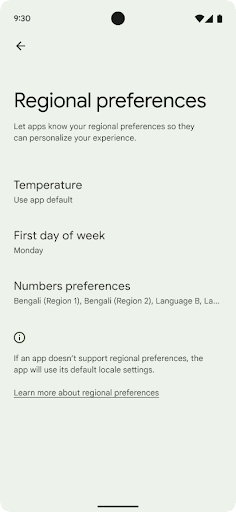
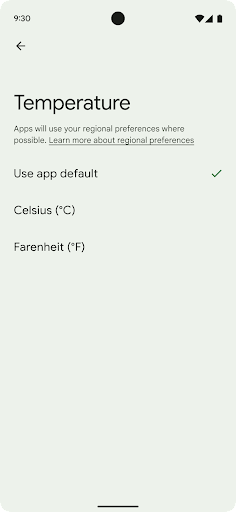
অ্যাক্সেসযোগ্যতা
নন-লিনিয়ার ফন্ট স্কেলিং 200%
অ্যান্ড্রয়েড 14 থেকে শুরু করে, সিস্টেমটি 200% পর্যন্ত ফন্ট স্কেলিং সমর্থন করে, কম দৃষ্টিভঙ্গি ব্যবহারকারীদের অতিরিক্ত অ্যাক্সেসিবিলিটি বিকল্পগুলি প্রদান করে যা ওয়েব সামগ্রী অ্যাক্সেসিবিলিটি নির্দেশিকা (WCAG) এর সাথে সারিবদ্ধ।
স্ক্রিনে বড় টেক্সট উপাদানগুলিকে খুব বড় স্কেলিং থেকে আটকাতে, সিস্টেমটি একটি ননলাইনার স্কেলিং কার্ভ প্রয়োগ করে। এই স্কেলিং কৌশলটির অর্থ হল বড় পাঠ্য ছোট পাঠ্যের মতো একই হারে স্কেল করে না। অরৈখিক ফন্ট স্কেলিং উচ্চ ডিগ্রীতে রৈখিক পাঠ্য স্কেলিং সংক্রান্ত সমস্যাগুলি প্রশমিত করার সময় বিভিন্ন আকারের উপাদানগুলির মধ্যে আনুপাতিক শ্রেণিবিন্যাস সংরক্ষণ করতে সহায়তা করে (যেমন পাঠ্য কাটা বা পাঠ্য যা অত্যন্ত বড় প্রদর্শনের আকারের কারণে পড়া কঠিন হয়ে যায়)।
ননলাইনার ফন্ট স্কেলিং দিয়ে আপনার অ্যাপ পরীক্ষা করুন
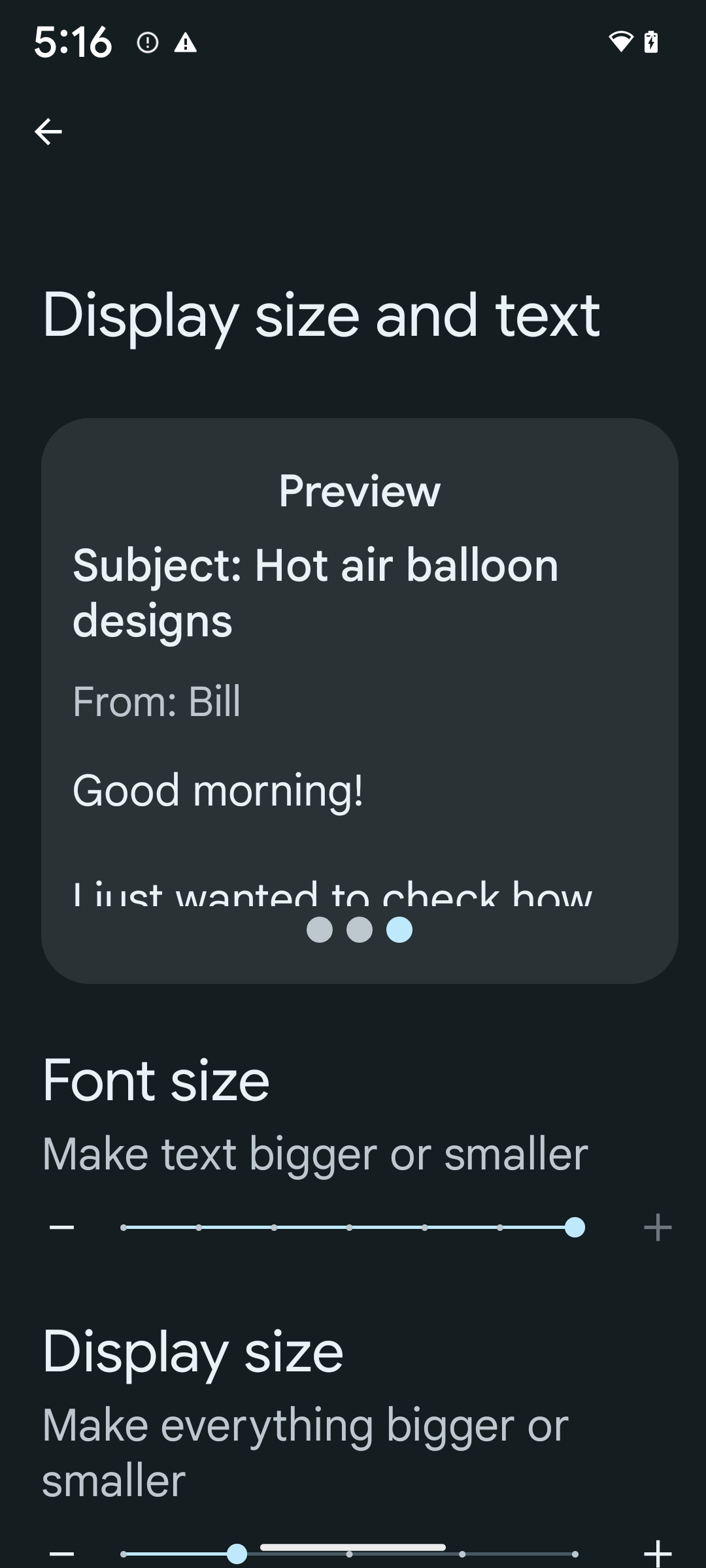
আপনি যদি ইতিমধ্যেই পাঠ্যের আকার নির্ধারণ করতে স্কেল করা পিক্সেল (এসপি) ইউনিট ব্যবহার করেন, তাহলে এই অতিরিক্ত বিকল্পগুলি এবং স্কেলিং উন্নতিগুলি আপনার অ্যাপের পাঠ্যে স্বয়ংক্রিয়ভাবে প্রয়োগ করা হয়। যাইহোক, আপনার অ্যাপটি সঠিকভাবে ফন্টের মাপ প্রয়োগ করে এবং ব্যবহারযোগ্যতাকে প্রভাবিত না করেই বড় ফন্টের আকার মিটমাট করতে পারে তা নিশ্চিত করার জন্য আপনাকে সর্বাধিক ফন্ট সাইজ সক্ষম (200%) সহ UI পরীক্ষা করা উচিত।
200% ফন্ট সাইজ সক্ষম করতে, এই পদক্ষেপগুলি অনুসরণ করুন:
- সেটিংস অ্যাপ খুলুন এবং অ্যাক্সেসিবিলিটি > ডিসপ্লে সাইজ এবং টেক্সটে নেভিগেট করুন।
- ফন্ট সাইজ বিকল্পের জন্য, প্লাস (+) আইকনে আলতো চাপুন যতক্ষণ না সর্বাধিক ফন্ট সাইজ সেটিং সক্ষম হয়, যেমনটি এই বিভাগের সাথে থাকা ছবিতে দেখানো হয়েছে।
পাঠ্য-আকারের জন্য স্কেল করা পিক্সেল (এসপি) ইউনিট ব্যবহার করুন
মনে রাখবেন সবসময় sp ইউনিটে টেক্সট মাপ নির্দিষ্ট করুন । যখন আপনার অ্যাপ এসপি ইউনিট ব্যবহার করে, তখন অ্যান্ড্রয়েড ব্যবহারকারীর পছন্দের টেক্সট সাইজ প্রয়োগ করতে পারে এবং যথাযথভাবে স্কেল করতে পারে।
প্যাডিংয়ের জন্য sp ইউনিট ব্যবহার করবেন না বা অন্তর্নিহিত প্যাডিং ধরে নিয়ে ভিউ উচ্চতা নির্ধারণ করবেন না: অরৈখিক ফন্ট স্কেলিং সহ sp মাত্রা সমানুপাতিক নাও হতে পারে, তাই 4sp + 20sp 24sp এর সমান নাও হতে পারে।
স্কেল করা পিক্সেল (এসপি) ইউনিট রূপান্তর করুন
এসপি ইউনিট থেকে পিক্সেলে রূপান্তর করতে TypedValue.applyDimension() ব্যবহার করুন এবং পিক্সেলকে sp-এ রূপান্তর করতে TypedValue.deriveDimension() ব্যবহার করুন। এই পদ্ধতিগুলি স্বয়ংক্রিয়ভাবে উপযুক্ত ননলাইনার স্কেলিং বক্ররেখা প্রয়োগ করে।
Configuration.fontScale বা DisplayMetrics.scaledDensity ব্যবহার করে হার্ডকোডিং সমীকরণ এড়িয়ে চলুন । যেহেতু ফন্ট স্কেলিং অরৈখিক, scaledDensity ক্ষেত্রটি আর সঠিক নয়। fontScale ক্ষেত্রটি শুধুমাত্র তথ্যগত উদ্দেশ্যে ব্যবহার করা উচিত কারণ ফন্টগুলি আর একক স্কেলার মান দিয়ে স্কেল করা হয় না।
লাইন উচ্চতার জন্য sp ইউনিট ব্যবহার করুন
সর্বদা dp এর পরিবর্তে sp ইউনিট ব্যবহার করে android:lineHeight সংজ্ঞায়িত করুন, যাতে আপনার পাঠ্যের সাথে লাইনের উচ্চতা স্কেল হয়। অন্যথায়, যদি আপনার পাঠ্য sp হয় কিন্তু আপনার lineHeight dp বা px-এ থাকে, তাহলে এটি স্কেল না করে এবং সঙ্কুচিত দেখায়। টেক্সটভিউ স্বয়ংক্রিয়ভাবে lineHeight সংশোধন করে যাতে আপনার অভিপ্রেত অনুপাত সংরক্ষিত থাকে, তবে শুধুমাত্র যদি textSize এবং lineHeight উভয়ই sp ইউনিটে সংজ্ঞায়িত করা হয়।
ক্যামেরা এবং মিডিয়া
ছবির জন্য আল্ট্রা এইচডিআর
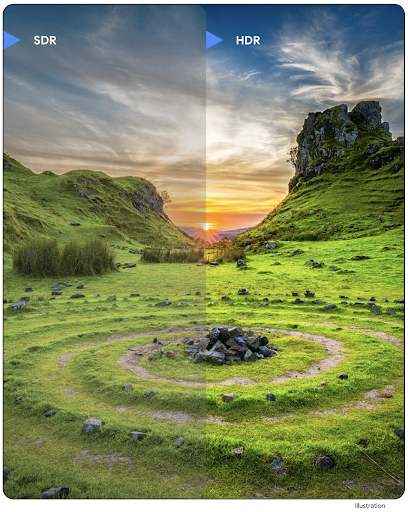
Android 14 হাই ডায়নামিক রেঞ্জ (HDR) চিত্রগুলির জন্য সমর্থন যোগ করে যা একটি ফটো তোলার সময় সেন্সর থেকে আরও তথ্য ধরে রাখে, যা প্রাণবন্ত রঙ এবং বৃহত্তর বৈসাদৃশ্য সক্ষম করে। অ্যান্ড্রয়েড আল্ট্রা এইচডিআর ফরম্যাট ব্যবহার করে, যা JPEG ছবির সাথে সম্পূর্ণ পশ্চাৎপদ সামঞ্জস্যপূর্ণ, অ্যাপগুলিকে HDR চিত্রগুলির সাথে নির্বিঘ্নে আন্তঃঅপারেটিং করার অনুমতি দেয়, সেগুলিকে প্রয়োজন অনুসারে স্ট্যান্ডার্ড ডায়নামিক রেঞ্জে (SDR) প্রদর্শন করে৷
HDR-এ UI-তে এই ছবিগুলি রেন্ডার করা ফ্রেমওয়ার্ক দ্বারা স্বয়ংক্রিয়ভাবে সম্পন্ন হয় যখন আপনার অ্যাপটি তার কার্যকলাপ উইন্ডোর জন্য HDR UI ব্যবহার করতে বেছে নেয়, হয় একটি ম্যানিফেস্ট এন্ট্রির মাধ্যমে বা রানটাইমে Window.setColorMode() কল করে । আপনি সমর্থিত ডিভাইসগুলিতে সংকুচিত আল্ট্রা এইচডিআর স্থির চিত্রগুলিও ক্যাপচার করতে পারেন। সেন্সর থেকে আরো রং উদ্ধারের সাথে, পোস্টে সম্পাদনা আরও নমনীয় হতে পারে। আল্ট্রা এইচডিআর ইমেজের সাথে যুক্ত Gainmap OpenGL বা Vulkan ব্যবহার করে রেন্ডার করতে ব্যবহার করা যেতে পারে।

Android 14 হাই ডায়নামিক রেঞ্জ (HDR) চিত্রগুলির জন্য সমর্থন যোগ করে যা একটি ফটো তোলার সময় সেন্সর থেকে আরও তথ্য ধরে রাখে, যা প্রাণবন্ত রঙ এবং বৃহত্তর বৈসাদৃশ্য সক্ষম করে। অ্যান্ড্রয়েড আল্ট্রা এইচডিআর ফরম্যাট ব্যবহার করে, যা JPEG ছবির সাথে সম্পূর্ণ পশ্চাৎপদ সামঞ্জস্যপূর্ণ, অ্যাপগুলিকে HDR চিত্রগুলির সাথে নির্বিঘ্নে আন্তঃঅপারেটিং করার অনুমতি দেয়, সেগুলিকে প্রয়োজন অনুসারে স্ট্যান্ডার্ড ডায়নামিক রেঞ্জে (SDR) প্রদর্শন করে৷
HDR-এ UI-তে এই ছবিগুলি রেন্ডার করা ফ্রেমওয়ার্ক দ্বারা স্বয়ংক্রিয়ভাবে সম্পন্ন হয় যখন আপনার অ্যাপটি তার কার্যকলাপ উইন্ডোর জন্য HDR UI ব্যবহার করতে বেছে নেয়, হয় একটি ম্যানিফেস্ট এন্ট্রির মাধ্যমে বা রানটাইমে Window.setColorMode() কল করে । আপনি সমর্থিত ডিভাইসগুলিতে সংকুচিত আল্ট্রা এইচডিআর স্থির চিত্রগুলিও ক্যাপচার করতে পারেন। সেন্সর থেকে আরো রং পুনরুদ্ধার করার সাথে, পোস্টে সম্পাদনা আরও নমনীয় হতে পারে। আল্ট্রা এইচডিআর ইমেজের সাথে যুক্ত Gainmap OpenGL বা Vulkan ব্যবহার করে রেন্ডার করতে ব্যবহার করা যেতে পারে।
ক্যামেরা এক্সটেনশনগুলিতে জুম, ফোকাস, পোস্টভিউ এবং আরও অনেক কিছু
Android 14 upgrades and improves camera extensions, allowing apps to handle longer processing times, which enables improved images using compute-intensive algorithms like low-light photography on supported devices. These features give users an even more robust experience when using camera extension capabilities. Examples of these improvements include:
- Dynamic still capture processing latency estimation provides much more
accurate still capture latency estimates based on the current scene and
environment conditions. Call
CameraExtensionSession.getRealtimeStillCaptureLatency()to get aStillCaptureLatencyobject that has two latency estimation methods. ThegetCaptureLatency()method returns the estimated latency betweenonCaptureStartedandonCaptureProcessStarted(), and thegetProcessingLatency()method returns the estimated latency betweenonCaptureProcessStarted()and the final processed frame being available. - Support for capture progress callbacks so that apps can display the current
progress of long-running, still-capture processing operations. You can check
if this feature is available with
CameraExtensionCharacteristics.isCaptureProcessProgressAvailable, and if it is, you implement theonCaptureProcessProgressed()callback, which has the progress (from 0 to 100) passed in as a parameter. Extension specific metadata, such as
CaptureRequest.EXTENSION_STRENGTHfor dialing in the amount of an extension effect, such as the amount of background blur withEXTENSION_BOKEH.Postview Feature for Still Capture in camera extensions, which provides a less-processed image more quickly than the final image. If an extension has increased processing latency, a postview image could be provided as a placeholder to improve UX and switched out later for the final image. You can check if this feature is available with
CameraExtensionCharacteristics.isPostviewAvailable. Then you can pass anOutputConfigurationtoExtensionSessionConfiguration.setPostviewOutputConfiguration.Support for
SurfaceViewallowing for a more optimized and power-efficient preview render path.Support for tap to focus and zoom during extension usage.
ইন-সেন্সর জুম
When REQUEST_AVAILABLE_CAPABILITIES_STREAM_USE_CASE in
CameraCharacteristics contains
SCALER_AVAILABLE_STREAM_USE_CASES_CROPPED_RAW, your app
can use advanced sensor capabilities to give a cropped RAW stream the same
pixels as the full field of view by using a CaptureRequest
with a RAW target that has stream use case set to
CameraMetadata.SCALER_AVAILABLE_STREAM_USE_CASES_CROPPED_RAW.
By implementing the request override controls, the updated camera gives users
zoom control even before other camera controls are ready.
লসলেস ইউএসবি অডিও
Android 14 gains support for lossless audio formats for audiophile-level
experiences over USB wired headsets. You can query a USB device for its
preferred mixer attributes, register a listener for changes in preferred mixer
attributes, and configure mixer attributes using the
AudioMixerAttributes class. This class represents the
format, such as channel mask, sample rate, and behavior of the audio mixer. The
class allows for audio to be sent directly, without mixing,
volume adjustment, or processing effects.
বিকাশকারীর উত্পাদনশীলতা এবং সরঞ্জাম
শংসাপত্র ম্যানেজার
Android 14 adds Credential Manager as a platform API, with additional support back to Android 4.4 (API level 19) devices through a Jetpack Library using Google Play services. Credential Manager aims to make sign-in easier for users with APIs that retrieve and store credentials with user-configured credential providers. Credential Manager supports multiple sign-in methods, including username and password, passkeys, and federated sign-in solutions (such as Sign-in with Google) in a single API.
Passkeys provide many advantages. For example, passkeys are built on industry standards, can work across different operating systems and browser ecosystems, and can be used with both websites and apps.
For more information, see the Credential Manager and passkeys documentation and the blogpost about Credential Manager and passkeys.
স্বাস্থ্য সংযোগ
Health Connect is an on-device repository for user health and fitness data. It allows users to share data between their favorite apps, with a single place to control what data they want to share with these apps.
On devices running Android versions prior to Android 14, Health Connect is available to download as an app on the Google Play store. Starting with Android 14, Health Connect is part of the platform and receives updates through Google Play system updates without requiring a separate download. With this, Health Connect can be updated frequently, and your apps can rely on Health Connect being available on devices running Android 14 or higher. Users can access Health Connect from the Settings in their device, with privacy controls integrated into the system settings.
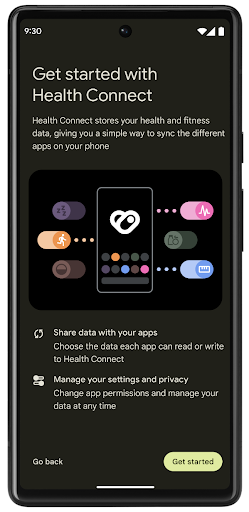
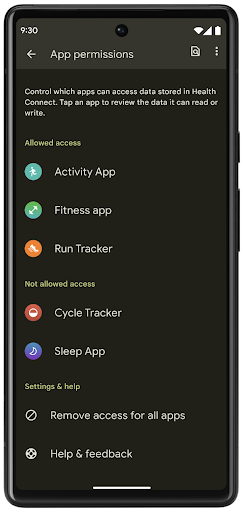
Health Connect includes several new features in Android 14, such as exercise routes, allowing users to share a route of their workout which can be visualized on a map. A route is defined as a list of locations saved within a window of time, and your app can insert routes into exercise sessions, tying them together. To ensure that users have complete control over this sensitive data, users must allow sharing individual routes with other apps.
For more information, see the Health Connection documentation and the blogpost on What's new in Android Health.
OpenJDK 17 আপডেট
অ্যান্ড্রয়েড 14 অ্যাপ এবং প্ল্যাটফর্ম ডেভেলপারদের জন্য লাইব্রেরি আপডেট এবং জাভা 17 ভাষা সমর্থন উভয় সহ সর্বশেষ OpenJDK LTS রিলিজের বৈশিষ্ট্যগুলির সাথে সারিবদ্ধ করার জন্য Android এর মূল লাইব্রেরিগুলিকে রিফ্রেশ করার কাজ চালিয়ে যাচ্ছে।
নিম্নলিখিত বৈশিষ্ট্য এবং উন্নতি অন্তর্ভুক্ত করা হয়েছে:
- জাভা 17 সমর্থনে প্রায় 300টি
java.baseক্লাস আপডেট করা হয়েছে। - টেক্সট ব্লক , যা জাভা প্রোগ্রামিং ভাষায় মাল্টি-লাইন স্ট্রিং লিটারেল প্রবর্তন করে।
- instanceof-এর জন্য প্যাটার্ন ম্যাচিং , যা কোনো বস্তুকে কোনো অতিরিক্ত ভেরিয়েবল ছাড়াই একটি
instanceofএকটি নির্দিষ্ট ধরণ হিসেবে গণ্য করার অনুমতি দেয়। - সীলমোহর করা ক্লাস , যা আপনাকে কোন ক্লাস এবং ইন্টারফেসগুলিকে প্রসারিত বা প্রয়োগ করতে পারে তা সীমাবদ্ধ করতে দেয়।
গুগল প্লে সিস্টেম আপডেট (প্রজেক্ট মেইনলাইন) এর জন্য ধন্যবাদ, 600 মিলিয়নেরও বেশি ডিভাইস সর্বশেষতম অ্যান্ড্রয়েড রানটাইম (ART) আপডেট পেতে সক্ষম হয়েছে যাতে এই পরিবর্তনগুলি অন্তর্ভুক্ত রয়েছে। এটি আমাদের অঙ্গীকারের অংশ যাতে অ্যাপগুলিকে ডিভাইস জুড়ে আরও সামঞ্জস্যপূর্ণ, সুরক্ষিত পরিবেশ দেওয়া যায় এবং প্ল্যাটফর্ম রিলিজ ছাড়া ব্যবহারকারীদের কাছে নতুন বৈশিষ্ট্য এবং ক্ষমতা প্রদান করা যায়।
Java এবং OpenJDK হল ওরাকল এবং/অথবা এর সহযোগীদের ট্রেডমার্ক বা নিবন্ধিত ট্রেডমার্ক।
অ্যাপ স্টোরের জন্য উন্নতি
Android 14 introduces several PackageInstaller APIs that
allow app stores to improve their user experience.
Request install approval before downloading
Installing or updating an app might require user approval.
For example, when an installer making use of the
REQUEST_INSTALL_PACKAGES permission attempts to install a
new app. In prior Android versions, app stores can only request user approval
after APKs are written to the install session and the
session is committed.
Starting with Android 14, the requestUserPreapproval()
method lets installers request user approval before committing the install
session. This improvement lets an app store defer downloading any APKs until
after the installation has been approved by the user. Furthermore, once a user
has approved installation, the app store can download and install the app in the
background without interrupting the user.
Claim responsibility for future updates
The setRequestUpdateOwnership() method allows an installer
to indicate to the system that it intends to be responsible for future updates
to an app it is installing. This capability enables update ownership
enforcement, meaning that only the update owner is permitted
to install automatic updates to the app. Update ownership enforcement helps to
ensure that users receive updates only from the expected app store.
Any other installer, including those making use of the
INSTALL_PACKAGES permission, must receive explicit user
approval in order to install an update. If a user decides to proceed with an
update from another source, update ownership is lost.
Update apps at less-disruptive times
App stores typically want to avoid updating an app that is actively in use because this leads to the app's running processes being killed, which potentially interrupts what the user was doing.
Starting with Android 14, the InstallConstraints API
gives installers a way to ensure that their app updates happen at an opportune
moment. For example, an app store can call the
commitSessionAfterInstallConstraintsAreMet() method to
make sure that an update is only committed when the user is no longer
interacting with the app in question.
Seamlessly install optional splits
With split APKs, features of an app can be delivered in separate APK files,
rather than as a monolithic APK. Split APKs allow app stores to optimize the
delivery of different app components. For example, app stores might optimize
based on the properties of the target device. The
PackageInstaller API has supported splits since its
introduction in API level 22.
In Android 14, the setDontKillApp() method allows an
installer to indicate that the app's running processes shouldn't be killed when
new splits are installed. App stores can use this feature to seamlessly install
new features of an app while the user is using the app.
অ্যাপ মেটাডেটা বান্ডেল
Starting in Android 14, the Android package installer lets you specify app metadata, such as data safety practices, to include on app store pages such as Google Play.
ব্যবহারকারীরা কখন ডিভাইসের স্ক্রিনশট নেয় তা শনাক্ত করুন
To create a more standardized experience for detecting screenshots, Android 14 introduces a privacy-preserving screenshot detection API. This API lets apps register callbacks on a per-activity basis. These callbacks are invoked, and the user is notified, when the user takes a screenshot while that activity is visible.
ব্যবহারকারীর অভিজ্ঞতা
শেয়ারশীট কাস্টম অ্যাকশন এবং উন্নত র্যাঙ্কিং
Android 14 updates the system sharesheet to support custom app actions and more informative preview results for users.
Add custom actions
With Android 14, your app can add custom actions to the system sharesheet it invokes.
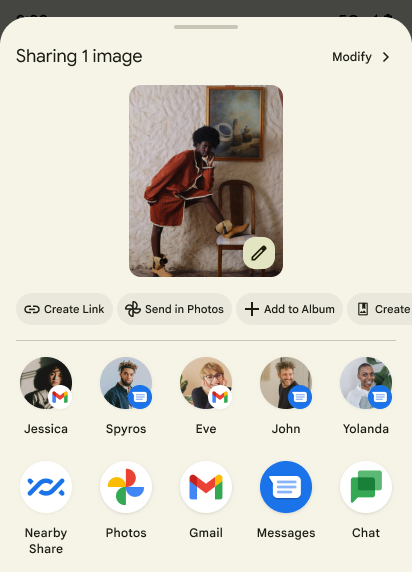
Improve ranking of Direct Share targets
Android 14 uses more signals from apps to determine the ranking of the direct share targets to provide more helpful results for the user. To provide the most useful signal for ranking, follow the guidance for improving rankings of your Direct Share targets. Communication apps can also report shortcut usage for outgoing and incoming messages.
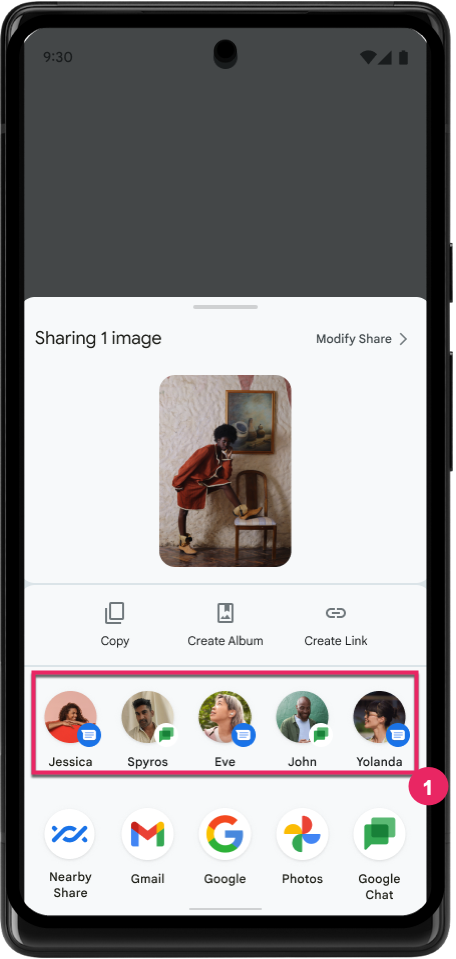
প্রেডিকটিভ ব্যাকের জন্য অন্তর্নির্মিত এবং কাস্টম অ্যানিমেশনের জন্য সমর্থন
Android 13 একটি বিকাশকারী বিকল্পের পিছনে ভবিষ্যদ্বাণীমূলক ব্যাক-টু-হোম অ্যানিমেশন চালু করেছে। ডেভেলপার বিকল্প চালু থাকা সমর্থিত অ্যাপে ব্যবহার করা হলে, পিছনে সোয়াইপ করা একটি অ্যানিমেশন দেখায় যা নির্দেশ করে যে পিছনের অঙ্গভঙ্গি অ্যাপ থেকে হোম স্ক্রিনে ফিরে আসে।
অ্যান্ড্রয়েড 14-এ একাধিক উন্নতি এবং ভবিষ্যদ্বাণীমূলক পিছনের জন্য নতুন নির্দেশিকা রয়েছে:
- আপনি সমগ্র অ্যাপের পরিবর্তে ক্রিয়াকলাপ প্রতি পূর্বাভাসমূলক ব্যাক সিস্টেম অ্যানিমেশন নির্বাচন করতে
android:enableOnBackInvokedCallback=trueসেট করতে পারেন। - আমরা অ্যান্ড্রয়েড 13 থেকে হোম-টু-হোম অ্যানিমেশনের সাথে নতুন সিস্টেম অ্যানিমেশন যোগ করেছি। নতুন সিস্টেম অ্যানিমেশনগুলি হল ক্রস-অ্যাক্টিভিটি এবং ক্রস-টাস্ক, যা আপনি প্রেডিকটিভ ব্যাক-এ স্থানান্তরিত করার পরে স্বয়ংক্রিয়ভাবে পেয়ে যাবেন।
- আমরা নীচের শীট , সাইড শীট এবং অনুসন্ধানের জন্য নতুন উপাদান উপাদান অ্যানিমেশন যুক্ত করেছি।
- আমরা কাস্টম ইন-অ্যাপ অ্যানিমেশন এবং ট্রানজিশন তৈরি করার জন্য ডিজাইন নির্দেশিকা তৈরি করেছি।
- কাস্টম ইন-অ্যাপ ট্রানজিশন অ্যানিমেশন সমর্থন করার জন্য আমরা নতুন API যোগ করেছি:
-
OnBackPressedCallbackinhandleOnBackStarted,handleOnBackProgressed,handleOnBackCancelled -
onBackStarted,onBackProgressed,OnBackAnimationCallbackinonBackCancelled - ট্রানজিশনের জন্য ওভাররাইড অ্যাক্টিভিটি
overridePendingTransitionপরিবর্তেoverrideActivityTransitionট্রানজিশন ব্যবহার করুন যা ব্যবহারকারীর পিছনে সোয়াইপ করার সাথে সাথে প্রতিক্রিয়া জানায়।
-
এই অ্যান্ড্রয়েড 14 প্রিভিউ রিলিজের সাথে, প্রেডিকটিভ ব্যাকের সমস্ত বৈশিষ্ট্য একটি বিকাশকারী বিকল্পের পিছনে থাকে। আপনার অ্যাপ্লিকেশানটিকে পূর্বাভাসমূলক পিছনে স্থানান্তর করতে বিকাশকারী নির্দেশিকা দেখুন, সেইসাথে কাস্টম ইন-অ্যাপ ট্রানজিশন তৈরি করার জন্য বিকাশকারী নির্দেশিকা দেখুন৷
প্রতি-অ্যাপ ওভাররাইড করে বড় স্ক্রীন ডিভাইস প্রস্তুতকারক
Per-app overrides enable device manufacturers to change the behavior of apps on large screen devices. For example, the FORCE_RESIZE_APP override instructs the system to resize the app to fit display dimensions (avoiding size compatibility mode) even if resizeableActivity="false" is set in the app manifest.
Overrides are intended to improve the user experience on large screens.
New manifest properties enable you to disable some device manufacturer overrides for your app.
প্রতি-অ্যাপ ওভাররাইড করে বড় স্ক্রীন ব্যবহারকারী
প্রতি-অ্যাপ ওভাররাইড বড় স্ক্রিনের ডিভাইসে অ্যাপের আচরণ পরিবর্তন করে। উদাহরণস্বরূপ, OVERRIDE_MIN_ASPECT_RATIO_LARGE ডিভাইস নির্মাতা ওভাররাইড অ্যাপের কনফিগারেশন নির্বিশেষে অ্যাপের আকৃতির অনুপাত 16:9 এ সেট করে।
Android 14 QPR1 ব্যবহারকারীদের বড় স্ক্রিনের ডিভাইসে একটি নতুন সেটিংস মেনুর মাধ্যমে প্রতি-অ্যাপ ওভাররাইড প্রয়োগ করতে সক্ষম করে।
অ্যাপ স্ক্রিন শেয়ারিং
অ্যাপ স্ক্রিন শেয়ারিং ব্যবহারকারীদের স্ক্রিন সামগ্রী রেকর্ডিংয়ের সময় পুরো ডিভাইস স্ক্রীনের পরিবর্তে একটি অ্যাপ উইন্ডো শেয়ার করতে সক্ষম করে।
অ্যাপ স্ক্রিন ভাগ করে নেওয়ার সাথে, স্ট্যাটাস বার, নেভিগেশন বার, বিজ্ঞপ্তি এবং অন্যান্য সিস্টেম UI উপাদানগুলি ভাগ করা ডিসপ্লে থেকে বাদ দেওয়া হয়। শুধুমাত্র নির্বাচিত অ্যাপের বিষয়বস্তু শেয়ার করা হয়।
অ্যাপ স্ক্রিন শেয়ারিং ব্যবহারকারীদের একাধিক অ্যাপ চালাতে সক্ষম করার মাধ্যমে উৎপাদনশীলতা এবং গোপনীয়তা উন্নত করে কিন্তু কন্টেন্ট শেয়ারিংকে একটি অ্যাপে সীমিত করে।
Pixel 8 Pro-এ Gboard-এ LLM-চালিত স্মার্ট রিপ্লাই
On Pixel 8 Pro devices with the December Feature Drop, developers can try out higher-quality smart replies in Gboard powered by on-device Large Language Models (LLMs) running on Google Tensor.
This feature is available as a limited preview for US English in WhatsApp, Line, and KakaoTalk. It requires using a Pixel 8 Pro device with Gboard as your keyboard.
To try it out, first enable the feature in Settings > Developer Options > AiCore Settings > Enable Aicore Persistent.
Next, open a conversation in a supported app to see LLM-powered Smart Reply in Gboard's suggestion strip in response to incoming messages.
গ্রাফিক্স
পথগুলি অনুসন্ধানযোগ্য এবং ইন্টারপোলেটেবল
Android's Path API is a powerful and flexible mechanism for
creating and rendering vector graphics, with the ability to stroke or fill a
path, construct a path from line segments or quadratic or cubic curves, perform
boolean operations to get even more complex shapes, or all of these
simultaneously. One limitation is the ability to find out what is actually in a
Path object; the internals of the object are opaque to callers after creation.
To create a Path, you call methods such as
moveTo(), lineTo(), and
cubicTo() to add path segments. But there has been no way to
ask that path what the segments are, so you must retain that information at
creation time.
Starting in Android 14, you can query paths to find out what's inside of them.
First, you need to get a PathIterator object using the
Path.getPathIterator API:
Kotlin
val path = Path().apply { moveTo(1.0f, 1.0f) lineTo(2.0f, 2.0f) close() } val pathIterator = path.pathIterator
Java
Path path = new Path(); path.moveTo(1.0F, 1.0F); path.lineTo(2.0F, 2.0F); path.close(); PathIterator pathIterator = path.getPathIterator();
Next, you can call PathIterator to iterate through the segments
one by one, retrieving all of the necessary data for each segment. This example
uses PathIterator.Segment objects, which packages up the data
for you:
Kotlin
for (segment in pathIterator) { println("segment: ${segment.verb}, ${segment.points}") }
Java
while (pathIterator.hasNext()) { PathIterator.Segment segment = pathIterator.next(); Log.i(LOG_TAG, "segment: " + segment.getVerb() + ", " + segment.getPoints()); }
PathIterator also has a non-allocating version of next() where you can pass
in a buffer to hold the point data.
One of the important use cases of querying Path data is interpolation. For
example, you might want to animate (or morph) between two different paths. To
further simplify that use case, Android 14 also includes the
interpolate() method on Path. Assuming the two paths have
the same internal structure, the interpolate() method creates a new Path
with that interpolated result. This example returns a path whose shape is
halfway (a linear interpolation of .5) between path and otherPath:
Kotlin
val interpolatedResult = Path() if (path.isInterpolatable(otherPath)) { path.interpolate(otherPath, .5f, interpolatedResult) }
Java
Path interpolatedResult = new Path(); if (path.isInterpolatable(otherPath)) { path.interpolate(otherPath, 0.5F, interpolatedResult); }
The Jetpack graphics-path library enables similar APIs for earlier versions of Android as well.
শীর্ষবিন্দু এবং খণ্ড শেডার সহ কাস্টম মেশ
Android has long supported drawing triangle meshes with custom shading, but the input mesh format has been limited to a few predefined attribute combinations. Android 14 adds support for custom meshes, which can be defined as triangles or triangle strips, and can, optionally, be indexed. These meshes are specified with custom attributes, vertex strides, varying, and vertex and fragment shaders written in AGSL.
The vertex shader defines the varyings, such as position and color, while the
fragment shader can optionally define the color for the pixel, typically by
using the varyings created by the vertex shader. If color is provided by the
fragment shader, it is then blended with the current Paint
color using the blend mode selected when
drawing the mesh. Uniforms can be passed
into the fragment and vertex shaders for additional flexibility.
ক্যানভাসের জন্য হার্ডওয়্যার বাফার রেন্ডারার
To assist in using Android's Canvas API to draw with
hardware acceleration into a HardwareBuffer, Android 14
introduces HardwareBufferRenderer. This API is
particularly useful when your use case involves communication with the system
compositor through SurfaceControl for low-latency
drawing.

